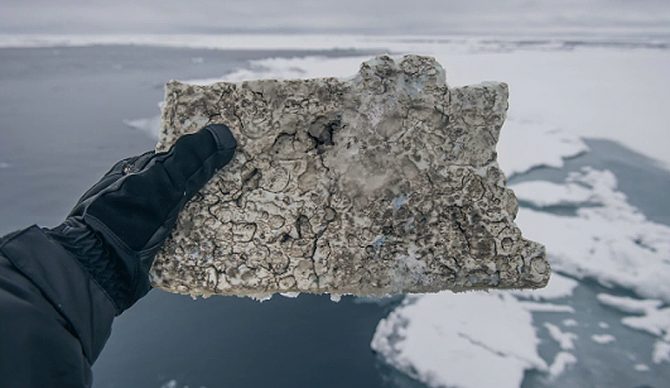
Scientists fear the blocks are breaking up into microplastics Photo: CONOR MCDONNELL @CONORMCDPHOTO
“There’s a ton of plastic floating in the ocean” isn’t exactly a groundbreaking statement at this point. But a new discovery from some Exeter University researchers is giving a new bit of perspective to the problem’s reach.
On a recent expedition in the Arctic, researchers from the university set out on a trip to the North Pole and were able to bring their ships further into the Central Arctic Ocean than any other in history, thanks to reductions in summer ice cover. Among other things, the Arctic Mission team used underwater speakers to study how sound travels in arctic waters and its effect on marine life there. Since the area is so desolate and typically covered in ice year round, it’s obviously quiet. The expectation is that less ice cover and more open water will open up the area to be exposed to commercial vessels and ships for the first time in its history. The environment is about to change drastically for anything that’s been living there.
Back to the plastic pollution problem, though. Scientists from the Arctic Mission also found blocks of polystyrene already floating in the same area hundreds of kilometers from land and until recently, completely covered by ice.
“Finding pieces of rubbish like this is a worrying sign that melting ice may be allowing high levels of pollution to drift into these areas,” said Marine biologist Tim Gordon. “The Arctic Ocean’s wildlife used to be protected by a layer of sea ice all year round. Now that is melting away, this environment will be exposed to commercial fishing, shipping, and industry for the first time in history. “We need to seriously consider how best to protect the Arctic’s animals from these new threats.”
The university’s Dr. Ceri Lewis explained that the plastic pollution in the Arctic isn’t the product of materials floating into the area, but instead a whole different problem. “Many rivers lead into the Arctic Ocean that are often a source of plastic pollution, but plastic pollution has been literally trapped into the ice,” says Lewis.
“Now the ice is melting we believe microplastics are being released into the Arctic. The Arctic is thought to be a hot spot of microplastics accumulation due to the number of rivers that empty into the Arctic basin, yet we have very little data to support this idea in the more northerly parts of the Arctic Ocean.”

